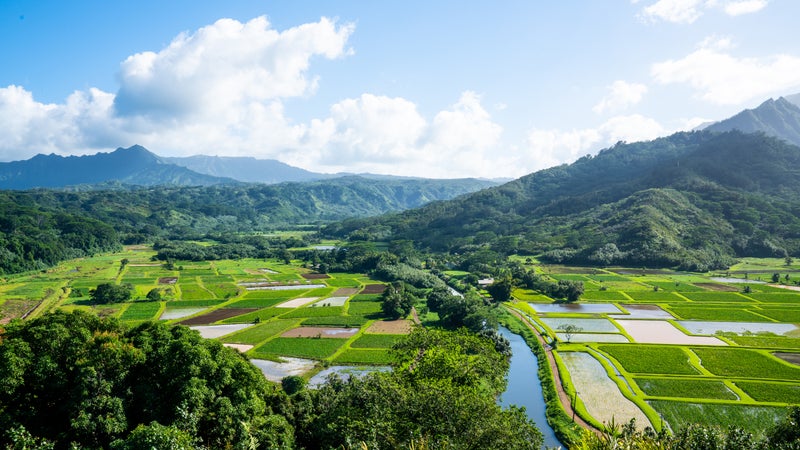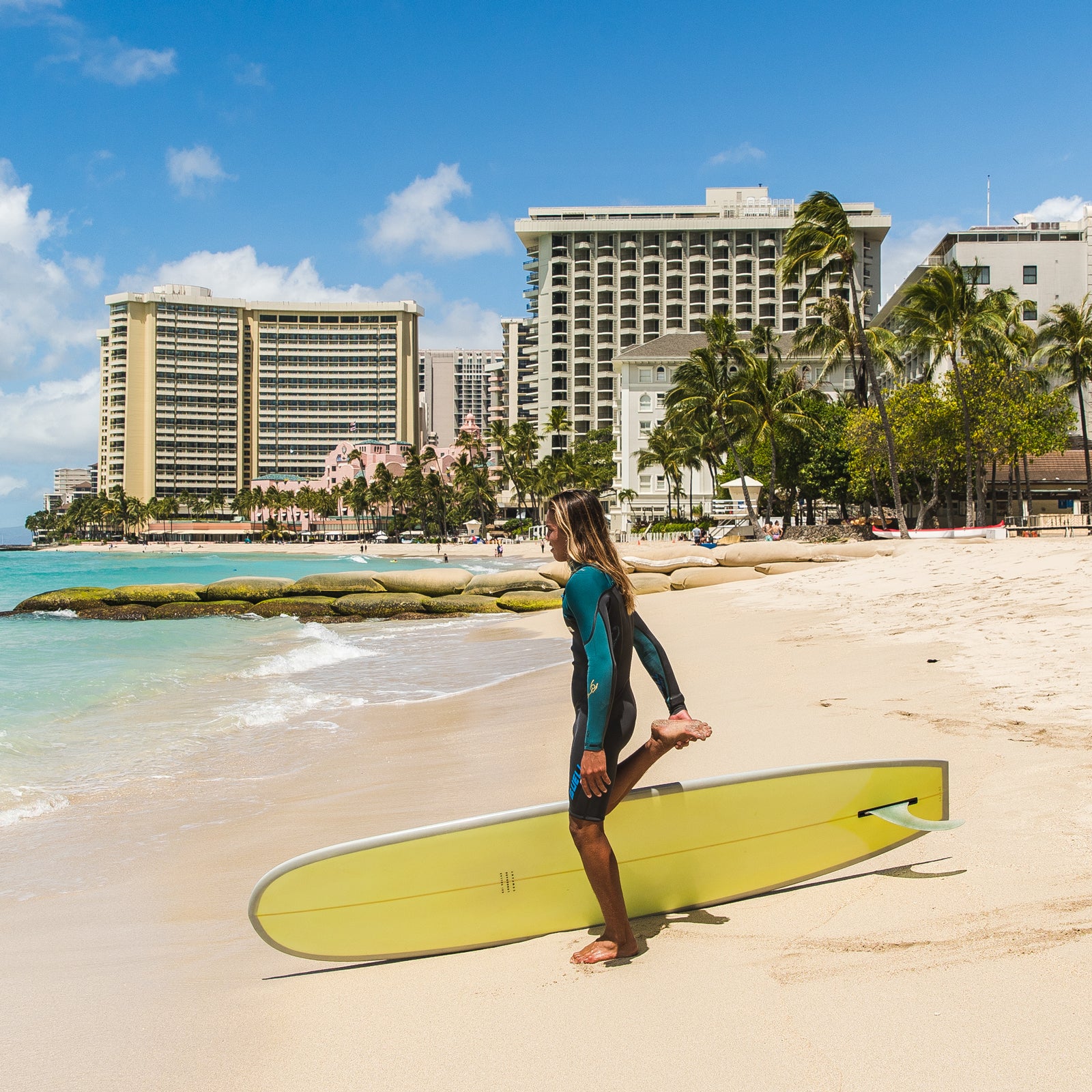“The pandemic was really the second disaster. The first one was the flood on Kauai,” says Alan Carpenter, assistant administrator of Hawaii’s . In April 2018, a record-breaking storm dumped more than four feet of rain in 24 hours on the north shore of Kauai, destroying hundreds of homes and the one road leading to the Na Pali Coast’s and its popular Kalalau Trail. Suddenly, one of Hawaii’s most visited attractions��went from seeing over 2,000 tourists a day to none.
Incidentally, just prior to the flood, DLNR and community members had finished drafting a��master plan��for Haena State Park, an effort 20 years in the making. It aimed to��control the crowds overwhelming the park and surrounding��towns, while also restoring the area’s��natural and cultural environment. The proposal included stream and loi (wetland taro field) restoration, stormwater and erosion mitigation, an overhaul of park facilities, a shuttle service, and a reservation system that would charge nonresidents and limit visitors to no more than 900 a day.
The original��timeline proposed introducing the changes in��five to ten��years (although, because of��permitting and funding challenges, 20 years was more likely). “At that moment, we had exactly $100,000 allotted to implement a multimillion-dollar plan,” says Carpenter. “And boom, here comes the flood, and with it $100 million of state emergency funding and several million tapped for park funding. The combination of that, along with the temporary lifting of all of the typical regulations and government red tape, made it an amazing opportunity. Without the flood, it wouldn’t have happened.”
A little more than a year after the flood, in June of 2019, Haena State Park reopened with all of its new regulations in place. “It changed the whole tenor of that area,” Carpenter says. “Everybody saw the success of Haena and wanted to apply it to other places.”
Visitors to the Hawaiian��Islands, which have a resident population of 1.4 million, have been steadily increasing over��the past decade, hitting��a record high of 10.4 million in 2019. As the number of tourists grew, so did concerns about traffic, overcrowding, and damage to the environment. In a 2019 Hawaii Tourism Authority , two-thirds of the residents polled believed that the state government was running the islands for tourists at the expense of locals. Tourism was leading to diminishing returns—adjusting for inflation, total visitor spending had fallen since 1989, despite an��increase of four million annual tourists since. Hawaii residents��were��getting fed up. New laws on Maui and Oahu cracked down on vacation rentals, for short-term units that hadn’t gone through the extensive permitting process. An existing ��at Oahu’s Kailua Beach, instituted in 2012, extended to Waimanalo beaches on the island’s east coast��as a way to curb tour buses and tourism-focused interests. The DLNR instituted at other parks to help pay for eroding infrastructure.
And then the pandemic hit. A mandatory 14-day quarantine for incoming travelers effectively closed Hawaii to tourism for seven months. “The pandemic did for the whole state what the flood did to the north shore of Kauai,” Carpenter says. “It shut it down and reset tourism to zero.”
Will the pandemic be a turning point for the state,��like the flood��was for Haena?

At��the beginning of COVID-19, as in��many other places, a stillness descended on Hawaii as residents sheltered at home. Pictures of empty beaches abounded on Instagram and in the media, but if you shifted your camera to the water, you’d see crowds of surfers in the ocean. For a time, shelter-in-place orders closed the beaches, but state law required public shoreline access, so residents were never forbidden from��the water, and from the unemployed to children unmoored from school, they took to the waves. Waikiki surf breaks were as packed��as they were during pre-pandemic times, but with locals.
According to Chana Makale‘a Dudoit Ane, resilience officer at the Maui County��, there used to be “tourists crowding the beaches” at multiple surf spots,��including Honolua Bay and near Kihei, “which made it uncomfortable being there. Now��there are tons of local people, you’re sharing waves, and it’s a different kind of vibe of culture and respect.” Wade Tokoro, shaper and owner of , says his sales have increased compared with��the previous year, something he attributes to locals surfing��more and beginners picking��up the sport.
Without the pressure of tourism, fish seemed to . Stores couldn’t keep fishing supplies in stock, and area��anglers��. For months, schools of halalu, an indigenous shad, swarmed Oahu’s usually tourist-dense Ala Moana and Kaimana Beaches like dark underwater clouds, and fishers��followed. Ane describes how one day she and her family were walking the shoreline in Kaehu, near a surf break called Churches, and “watched an old-timer throwing a net to catch his dinner.” He was tracking schools of nehu. The man told Ane that the ancestral��name for both this��place and the surf break were��called Nehu, and that it was a site��frequented by alii (traditional Hawaiian royalty) and chiefs back in the day.
Even the food banks have become a resource for cultural knowledge in these tough pandemic times.��When��the��, on Hawaii Island, faced a rice shortage, it��distributed ulu, or breadfruit, which was brought to the islands by the��first Polynesian inhabitants. Rice, despite being a staple in local cuisine, is imported, and as food insecurity skyrocketed and supply chains were disrupted, it became hard to come by.��The , formed in 2016 to promote production of ulu and develop a market for it,��stepped in and supplied the Food Basket with the healthier alternative, introducing many locals to the product for��the first time, says Dana Shapiro, the cooperative’s manager.��“Ulu could save the day in the starch category, which is how we’ve always thought about it,” Shapiro says.
At the start of the pandemic, many hoped that the state would take the��pause in tourism to address overtourism, as with Haena State Park. But COVID-19��has wreaked economic devastation on Hawaii. Tourism’s shutdown led to increasing homelessness, and the unemployment rate jumped to 23 percent. So unlike the aftermath of Haena’s floods, Hawaii’s state parks have not seen a swift infusion of federal emergency money; instead, most funding has gone��toward��helping households and small businesses directly affected by the pandemic. Between the drop in nonresident visitors and a loss of vendor contracts, the DLNR has estimated its losses at $500,000 a month.
Because of this, minimal state-level action has taken place��since the start of the pandemic to��proactively address��future overtourism. Many of the protocols that have been instituted since March 2020 were in��the pipeline before the pandemic hit; namely, a fee increase across eight state parks was finalized in October��(though parking and entrance for residents remains free), and a new reservation system will be introduced at on Maui’s Hana Highway in March. The only direct change as a result of the pandemic was outside of DLNR’s jurisdiction,��at Honolulu County’s Hanauma Bay: a first-ever daily visitor cap of 720 was set in January, reducing the number of permitted visitors from��3,000, the��average daily figure seen��in 2019.
There is some evidence that the Hawaii Tourism Authority��is shifting its focus from marketing for more tourists to managing visitors’��impact on the islands. In September, the HTA hired John De Fries as its president and CEO, the first Native Hawaiian to serve in those��roles, and last��fall��it began drafting Destination Management Action Plans for each of the islands, with community input. In February, it released , and the other islands are slated to follow with theirs shortly. Among the recommendations for Kauai tourism: better management of natural resources (to be funded by increased��user fees), a limitation on��visitors, and enforced��rest days. However, the HTA does not currently have any kind of enforcement authority, so it remains to be seen if anything becomes of this wish list.
“Everyone’s seen the adverse effects that tourism really brings to our natural environment, but also understands it’s a necessary part of our beating hearts, so to speak. So how do we manage it effectively?”
In place of larger measures, some of the state’s conservation nonprofits have experimented with small-scale models during this forced pause.
Calling to mind the Depression-era Civilian Conservation Corps, a portion of Hawaii’s CARES money went to hiring and training��unemployed residents to work in conservation. Among the programs that qualified were , which teaches��local youth about��land preservation; the Aloha Aina Workforce Program on Kauai, which gave agricultural roles to��two dozen workers who lost their jobs due to COVID-19; and a partnership with the . The last initiative sought to retrain a workforce previously employed by tourism for positions��in the natural-resources sector, bringing on��70 people across seven land and sea nonprofits; workers restored��loi fields,��which help retain water and reduce sediment runoff into the ocean,��recovered ancient fish ponds��that help curb coastal erosion,��removed invasive plants,��and learned about watershed management and stream maintenance.
“I would say that every one of them would like to continue doing what they were doing, if they could,” says Ekolu Lindsey, a board member of the Maui Nui Marine Resource Council and , another nonprofit that has��been rebuilding loi fields. After the CARES money ran out at the end of last year, 6��of the 17 people��hired by Kipuka Olowalu were able to continue employment in the environmental or farming sectors.
“Everyone’s seen the adverse effects that tourism really brings to our natural environment, but also understands it’s a necessary part of our beating hearts. So how do we manage it effectively?” asks Lindsey.��Rather than replacing tourism with another industry, he sees tourism as a way to fund investment and provide labor to restore cultural practices. Tourists on vacation in Hawaii might be interested in, say, repairing a native fishpond and learning about the ancient ahupuaa system of land division, he hopes.
His vision is also a way of sharing Indigenous knowledge.��Hawaii’s people, language, culture, flora, and fauna have��long been negatively affected by outside forces.��In the��1970s, a modern Hawaiian renaissance began with a revival��of��the language and cultural practices that were nearly lost, like hula. The next step is to share this��culture outside Hawaii; one such effort was��Malama Honua, a worldwide voyage of the Polynesian canoe��, which sailed to 23 countries from 2013 to��2019��using traditional��way-finding techniques.

On Hawaii Island, Kuhao Zane, creative director of clothing retailer Sig Zane Designs,��is active in��the��, named after Zane’s grandmother, a revered hula and Hawaiian-culture practitioner. The foundation��focuses on sharing Indigenous knowledge��and the role it can serve in this modern time, whether in school curriculums or proper resource management in culturally significant areas. A few months ago, Zane and his cousin were enjoying a relatively empty beach when they overheard a tour guide telling stories about the place. “It didn’t have the right depth of Hawaiian culture that we felt we could share,” he says. They are now working with the HTA and the Hawaii Visitors and Convention Bureau on developing a knowledge-certification program for those employed in tourism.
Right now, Zane is looking to his own heritage for some answers. “Coming from a hula background, we call these kinds of times hulihia, or ‘big upheavals,’” he says. “A lot of the chants talk about big lava flows, earthquakes, whole forests going down. These are times of constant change.” He’s in the process of translating the texts of chants��to “take a look at the chants that happen after hulihia,” he says.��“Maybe that could give you some inkling of what’s to come.”


